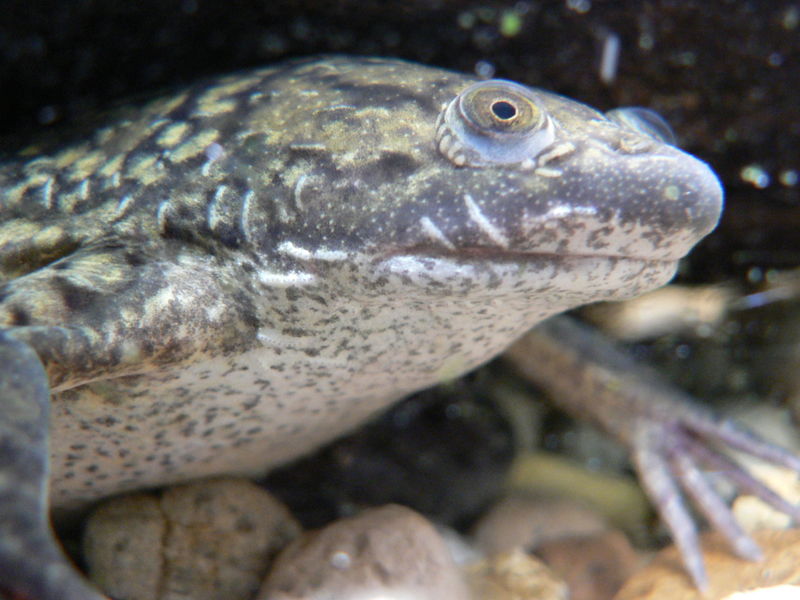
Note: Dwarf African Frogs, Hymenochirus spp., require an entirely different diet comprised of small live invertebrates. Please see this article for details. Another relative, the bizarre, skin-brooding Surinam Toad, Pipa pipa, is also a live food specialist (please see photo and this article.
Strange Food…No problem!
African Clawed Frogs are among the world’s most adaptable amphibians. Escaped pets and lab animals have established huge populations in such far-flung locales asJapan,California,England,Braziland elsewhere.
These introduced frogs feed upon prey that is not found in their native habitat, southernAfrica, yet they thrive and often out-compete (or consume!) local species. This innate toughness simplifies the feeding of captives…several of mine have lived into their 20’s, and the published longevity record is just over 30 years
Reptomin-Based Diet
Reptomin Food Sticks are my first choice as a commercial food for Clawed Frogs. I have used it as a staple diet for many years, and find that it meets most of this species’ needs. Reptomin Select-A-Food contains small shrimps and plankton as well as food sticks, making it perhaps the best option of all. If convenience and safety are your main concerns, this diet is the way to go.
You can use Reptomin for at least 75% of your frog’s diet. To this you should add Freeze Dried Shrimps or Prawn and some live food. The best live foods to use are earthworms, blackworms and guppies or minnows.
Alternative foods and treats that can be offered on an occasional basis include crickets, waxworms and any aquatic turtle pellet.
Live Food Diet
This diet is the reverse of the above – approximately 75% live/natural food and 25% Reptomin. As wide a variety of live prey as possible should be used, but be sure to concentrate on a few well-proved frog “health foods”. These include earthworms, guppies, minnows and other small fishes, blackworms and, to a lesser degree, crickets. Mealworms are not ideal, although newly-molted (white) grubs and pupae are fine. You can also offer wild-caught insects – please see the article below for more info.
 Feeding live food in a large, well-planted tank is a great way to observe your frogs’ natural hunting abilities. The Clawed Frogs that I kept in outdoor ponds were among my best breeders. They caught their own food all summer, and when brought indoors displayed hunting abilities that were noticeably different from those of their tank-raised cousins…they would even come almost completely out of the water to snatch insects from the shore.
Feeding live food in a large, well-planted tank is a great way to observe your frogs’ natural hunting abilities. The Clawed Frogs that I kept in outdoor ponds were among my best breeders. They caught their own food all summer, and when brought indoors displayed hunting abilities that were noticeably different from those of their tank-raised cousins…they would even come almost completely out of the water to snatch insects from the shore.
Other Options for Tadpoles and Adult Frogs
The diets covered here were chosen because they are simple and have worked well over many years. There are many other options – please write in with your own and I’ll highlight them in the future.
The filter-feeding tadpoles are much “fussier” than adult Clawed Frogs, but with them there are several possibilities. Please see the article below for a great diet provided by a reader, and some notes on my own experiences.
Further Reading
African Clawed Frog image referenced from wikipedia and originally posted by Peter Halasz
Surinam Toad image referenced from wikipedia and originally posted by Dein Freund der Baum
 That Reptile Blog – Reptile, Amphibian and Exotic Pet Care and Information
That Reptile Blog – Reptile, Amphibian and Exotic Pet Care and Information



Hi, Frank! Great info, but on my group and website we don’t recommend Minnows, or “Rosy Reds”, as, like Goldfish, these have a unique bone structure that can damage the digestive system. To be safe, we only recommend feeder guppies because “minnow” is a term used for a FEW different fish, some of them dangerous. Perhaps you meant one of the species that are benign? Note that minnows and Goldfish also contain thiaminase, an enzyme that prevents Vitamin B-1 absorption. I have 9 ACFs, laevis and borealis; my xenopus laevis Vera is over 28 years old.
Hello Alyce,
Thanks for the kind words.
I’ve not run across any info re bone structure, but please send along if you have documentation. I’ve been using a wide variety of minnows – rosy reds and other species – at the Bronx Zoo and personal collection for 50+ years with very good results. They remain in use in all major US zoos for this species, as well as Pipa pipa, and related; including for extremely rare species, i.e. Telmatobias spp.
The thiamase issue is quite complicated, much more so than is usually discussed on the net; there are no concerns if the animals are fed a varied balanced diet.
All dead animals at the Bronx zoo are subject to necropsy, vet reviews, etc…I believe any problems related to above would have been documented, as the fish mentioned have been used for many decades,way before my long tenure there.
Goldfish have been linked to liver and kidney problems in mata mata turtles, Chelus fimbriatus (work originally done by colleagues of mine); details still not clear as far as I know, but their use with other species should be limited, mainly as a precaution.
X laevis amazingly hardy and adaptable; longevities are, in contrast to most frogs, not always reliable as to value of diet; lab animals often live very long lives, and breed, on beef liver alone; introduced populations live in brackish ponds and cold, underground water supply systems (UK) eating unusual diets; pets often thrive despite very poor diets, etc (not to encourage such, of course!).
best, Frank